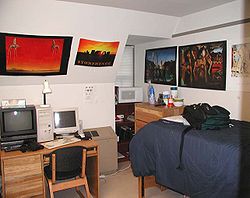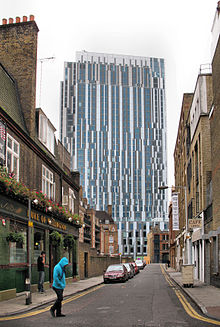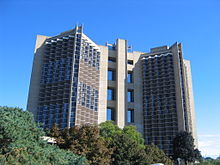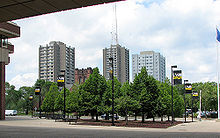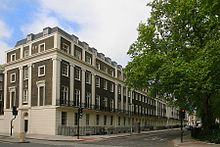- Dormitory
-
A dormitory, often shortened to dorm, in the United States is a residence hall consisting of sleeping quarters or entire buildings primarily providing sleeping and residential quarters for large numbers of people, often boarding school, college or university students. In the UK, the word has an earlier, different but related meaning: it refers specifically to an individual room in which many people sleep, typically at a boarding school. The UK equivalent of the American word as applied to university buildings is hall of residence, often shortened to halls.
Contents
Higher education
Most colleges and universities provide single or multiple occupancy rooms for their students, usually at a cost. These buildings consist of many such rooms, like an apartment building, and the number of rooms varies quite widely from just a few to hundreds. The largest dormitory building is Bancroft Hall at the United States Naval Academy.
Many colleges and universities no longer use the word "dormitory" and staff are now using the term residence hall (analogous to the United Kingdom "hall of residence") or simply "hall" instead. This is promoted[who?] as better describing a living and learning community that is part of the larger academic institution.[citation needed] When the word "dorm" was first adapted for universities and colleges, the atmosphere of the buildings served as places for students to sleep. Often students had a curfew to be in the building for "lights out" and a "dorm mother" was in charge of running the building. This is no longer true as residence halls as of 2007 strive to provide a more inclusive[citation needed] community for residents. Features of life such as cafeterias, academic centers, active and passive[clarification needed] programming, resident assistants and hall coordinators have given a new[citation needed] experience to living on campus.
College and university residential rooms vary in size, shape, facilities and number of occupants. Typically, a United States residence hall room holds two students with no toilet. This is usually referred to as a "double". Often, residence halls have communal bathroom facilities.
In the United States, residence halls are sometimes segregated by sex, with men living in one group of rooms, and women in another. Some dormitory complexes are single-sex with varying limits on visits by persons of each sex. For example, the University of Notre Dame in Indiana has a long history of Parietals, or mixed visiting hours. Most colleges and universities offer coeducational dorms, where either men and women reside on separate floors but in the same building or where both sexes share a floor but with individual rooms being single-sex. In the early 2000s, dorms that allowed people of opposite sexes to share a room became available in some public universities.[1] Some colleges and university coeducational dormitories also feature coeducational bathrooms.
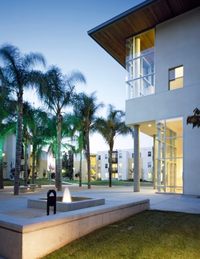 Coeducational residential suites at Cal Poly Pomona
Coeducational residential suites at Cal Poly Pomona
Most residence halls are much closer to campus than comparable private housing such as apartment buildings. This convenience is a major factor in the choice of where to live since living physically closer to classrooms is often preferred, particularly for first-year students who may not be permitted to park vehicles on campus. Universities may therefore provide priority to first-year students when allocating this accommodation.
Halls located away from university facilities sometimes have extra amenities such as a recreation room or bar. As with campus located residence halls, these off-campus halls commonly also have Internet facilities, either through a network connection in each student room, a central computer cluster room, or Wi-Fi. Catered halls may charge for food by the meal or through a termly subscription. They may also contain basic kitchen facilities for student use outside catering hours. Most halls contain a laundry room.
In UK universities these buildings are usually called "halls of residence" (commonly referred to as "halls"), except at Oxford, Cambridge, Durham, St Andrews, York, Lancaster and Kent where the residential accommodation is incorporated in each college's complex of buildings, and simply known as "rooms". (Members of the college who live in its own buildings are usually said to be "living in", or "living in college"), although "halls of residence" is still used at times.
The majority of bedrooms in UK halls are now single occupancy - offering the first chance at privacy for some young people who shared bedrooms with siblings at home. Kitchen facilities are usually shared, as are bathrooms in some halls, though more expensive en suite rooms are available in some universities.
In Germany there are dormitories called "Studentenwohnheim" (plural: Studentenwohnheime). Most Studentenwohnheime are run by the Studentenwerk ("student union", an organisation providing social, financial and cultural support services to students in Germany). Some are run by a Catholic or Protestant church. Church-run facilities are sometimes single-sex. Studentenwohnheime may be on Campus or outside of Campus. They are usually low cost and serve poorer students.
Terminology
 Broward Hall, at the University of Florida
Broward Hall, at the University of Florida
The terms "residence hall" and "dorm" are often used interchangeably in the US. However, within the residence life community, the term "residence hall" is preferred. According to the University of Oregon, their facilities "provide not just a place to sleep, but also opportunities for personal and educational growth. Highly trained Residence Life staff and Hall Government officers support this objective by creating engaging activities and programs in each hall or complex."[2]
Notable dormitories
Michigan State University in East Lansing, Michigan has the largest residence hall system in the United States. 16,000 students live within 23 different undergraduate buildings, one graduate hall, and three apartment villages. Freshmen are required to live on the 45,000+ student campus for at least their first year.[3] Watterson Towers at Illinois State University are among the tallest residence halls in the world. The 28-story complex, which was built in 1967 holds over 2,200 students and its buildings are 91 meters tall.
The Sandburg Halls at University of Wisconsin–Milwaukee consists of four high rise towers, with the tallest being the northern most tower reaching 74 metres (243 ft) tall (building), and 146.8 metres (482 ft) (radio antenna).[4] The halls combined have a total housing capacity of 2,700 students.[5]
Dobie Center, an off-campus, 27-story private dormitory next to The University of Texas at Austin, stands at 112 metres (367 ft). In addition to being a private residence for students, Dobie also contains a 2-story mall, a movie theater, restaurants, and specialty stores.
The Valkendorfs Kollegium at the University of Copenhagen was founded in 1589. Though not as old as some of the colleges of Oxford and Cambridge, it is among the oldest dormitories in the world. The Stone Frigate at Royal Military College of Canada in Kingston, Ontario was constructed in 1820 to store part of the dismantled fleet from the War of 1812. The former warehouse was converted into a dormitory and classrooms when the college was established in 1874. The Stone Frigate, a designated heritage building, was closed for more than 18 months for major renovations to the interior and exterior of the dormitory. The Capstone House at University of South Carolina in Columbia, South Carolina completed in 1967, standing at 18 stories, has the only revolving restaurant on an American college campus located on the 18th floor known as Top of Carolina Dining Room.
 The Sky Plaza in Leeds, the world's second tallest student accommodation block.
The Sky Plaza in Leeds, the world's second tallest student accommodation block.
Nido Spitalfields in London is the world's tallest student accommodation building, standing at 105 metres (344 ft), with 33 floors.[6] It was completed in 2010 and claimed the title from the previous record holder, Sky Plaza in Leeds which stands just two metres lower.
Hall governments
At some institutes, each residence hall has its own hall council. Where they exist, such individual councils are usually part of a larger organization called, variously, Residence Hall Association, Resident Students Association, or Junior Common Room Committee which typically provides funds and oversees the individual building council. These student led organizations are typically connected at a national level by the National Association of College and University Residence Halls (NACURH). Collectively, these hall councils plan social and educational events, and voice student needs to their respective administration.
Staffing
In the United States, university residence halls are normally staffed by a combination of both students and professional residence life staff. Student staff members or Resident Assistants, act as liaisons, counselors, mediators and policy enforcers. The student staff is supervised by a graduate student or a full-time residence life professional. Staff members frequently arrange programming activities to help residents learn about social and academic life during their college life.
In the United Kingdom, halls often run a similar setup to that in the U.S, although the resident academic responsible for the hall is known by the term of "warden" and may be supported by a team of vice-wardens, sub-wardens or senior-members; forming the SCR (Senior Common Room). These are often students or academic staff at the relevant university/college. Many UK halls also have a JCR (Junior Common Room) committee, usually made up of second year students who stayed in that hall during their first year.
The facilities in the hall are often managed by an individual termed the Bursar. Residence Halls may have housekeeping staff to maintain the cleanliness of common rooms including lobbies and bathrooms. Students are normally required to maintain the cleanliness of their own rooms and private or semi-private bathrooms, where offered.
United States military
Dormitories have replaced barracks at most U.S. military installations. Much new construction includes private bathrooms, but most unaccompanied housing as of 2007[update] still features bathrooms between pairs of rooms. Traditional communal shower facilities, typically one per floor, are now considered substandard and are being phased out.
U.S. military dormitory accommodations are generally intended for two junior enlisted single personnel per room, although in most cases this is slowly being phased out in favor of single occupancy in accordance with newer Department of Defense standards.
All branches of the U.S. military except the Air Force still refer to these dormitory-style accommodations as "barracks". The Air Force, in contrast, refers to all unaccompanied housing as "dormitories", including open-bay barracks used for basic training that house dozens per room, as well as unaccompanied housing for senior ranking personnel, which resemble apartments and are only found in a select number of overseas locations.
Sleeping dormitories
In the U.S., UK and Canada, a dormitory has a different meaning, and is used for a room with more than one bed. Examples are found in British boarding schools and many rooming houses such as hostels but have nowadays completely vanished as a type of accommodation in university halls of residence. CADs, or Cold-Air Dormitories, are found in multi-level rooming houses such as fraternities, sororities, and cooperative houses. In CADs and in hostels, the room typically has very few furnishings except for beds. Such rooms can contain anywhere from three to 50 beds (though such very large dormitories are rare except perhaps as military barracks). Such rooms provide little or no privacy for the residents, and very limited storage for personal items in or near the beds.
Company dormitories
While the practice of housing employees in company-owned dormitories has dwindled, several companies continue this practice in the U.S. and other countries.
Cast Members in the Disney College Program at the Walt Disney World Resort have the opportunity to meet and live with other Cast Members within their housing complexes in Lake Buena Vista, FL.[7] In the Netherlands, the law forbids companies to offer housing to their employees, because the government wants to prevent people who have just lost their job adding to their stressful situation by having to search for new housing. In Japan, many of the larger companies as well as some of the ministries still offer to their newly graduated freshmen a room in a dormitory. A room in such a dormitory often comes with a communal cook (for the men) or rooms with furnished kitchen blocks (for the women). Usually the employees pay a very small amount of money to enable the men (especially) to save money to buy a house when they get married.
Prisons
Housing units in prisons that house more than the one or two inmates normally held in cells are referred to as "dormitories" as well. Housing arrangements can vary widely. In some cases, dormitories in low-security prisons may almost resemble their academic counterparts, with the obvious differences of being locked at night, being administered by jailers, and subject to stricter institutional rules and fewer amenities. In other institutions, dormitories may be large rooms, often converted from other purposes such as gymnasiums in response to overcrowding, in which hundreds of prisoners have bunks and lockers.
Floating dormitories
A floating dormitory is a water-borne vessel that provides, as its primary function, living quarters for students enrolled at an educational institution. A floating dormitory functions as a conventional land-based dormitory in all respects except that the living quarters are aboard a floating vessel. A floating dormitory is most often moored in place near the host educational facility and is not used for water transport. Dormitory ships may also refer to vessels that provide water-borne housing in support of non-academic enterprises such as off-shore oil drilling operations. Other vessels containing living quarters for students as ancillary support to the vessel's primary function — such as for providing maritime or other training given aboard the vessel — are more appropriately categorized as training ships.
Notable among floating dormitories is SS Stevens, a 473-foot, 14,893-ton ship operated by Stevens Institute of Technology, a technological university, in Hoboken, New Jersey. From 1968 to 1975, Stevens served as the floating dormitory for as many as 150 students of the institute.
See also
- List of dormitory buildings
- Hostel
- Barracks
- Public housing
- Scholarship hall
References
- ^ "In student housing, is the coed room the wave of the future?". Pittsburgh Post-Gazette. 2002-02-26. http://www.post-gazette.com/lifestyle/20020226dorms26P9.asp.
- ^ "Michigan State University - Housing - Prospective Students". http://uh.msu.edu/parents/prospective_students.html.
- ^ "University of Oregon - Housing". http://housing.uoregon.edu/reshalls/.
- ^ "Sandburg Hall North, Milwaukee". http://skyscraperpage.com/cities/?buildingID=3655.
- ^ "University of Wisconsin-Milwaukee University Housing Website". University of Wisconsin–Milwaukee. http://www4.uwm.edu/housing/communities/sandburg/. Retrieved 2010-10-26.
- ^ "The World's Tallest Student Accommodation Building To Open In London This September". http://www.nidostudentliving.com/__assets/asset674.pdf. Retrieved 2011-02-09.
- ^ https://www.wdwcollegeprogram.com/sap/its/mimes/zh_wdwcp/students/housing/housing_overview.html
External links
- Association of College and University Housing Officers - International
- The Evolution of the College Dorm
Categories:- Rooms
- House types
- University and college residential buildings
Wikimedia Foundation. 2010.

